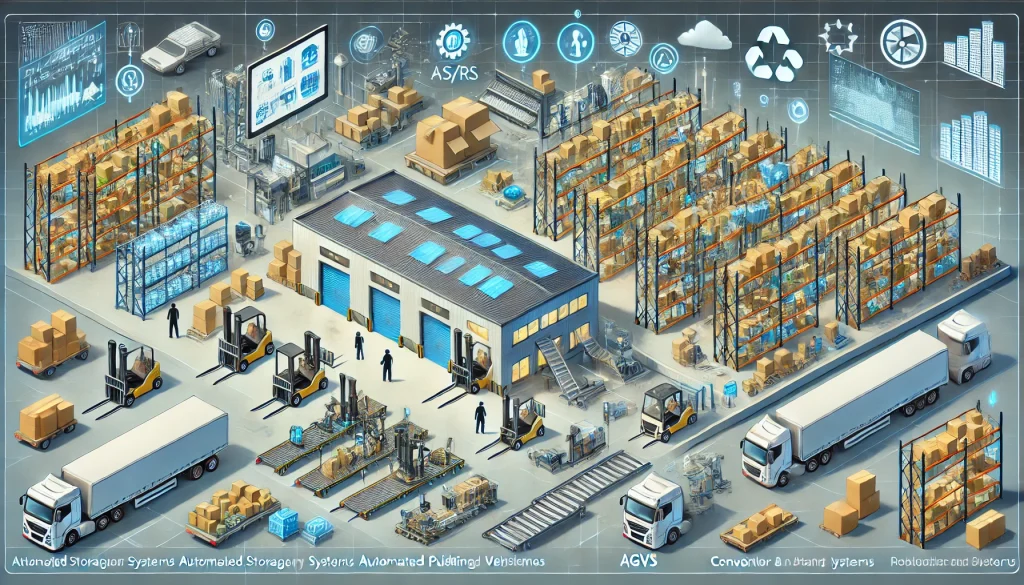The Path to Warehouse Excellence: Comprehensive Strategies to Optimise Your Warehouse

Fundamentals of Warehouse Optimisation
Warehouse optimization is an ongoing process of improving the efficiency and effectiveness of warehouse operations. It encompasses a wide range of activities, from layout design and inventory management to process streamlining and technology integration. The ultimate goal is to maximize productivity, reduce costs, and improve customer satisfaction.
The Optimization Cycle: Assess, Plan, Implement, Review
- Assess: Conduct a thorough analysis of current operations, identifying bottlenecks and inefficiencies.
- Plan: Develop strategies and set clear, measurable objectives for improvement.
- Implement: Execute optimization strategies, often in phases to minimize disruption.
- Review: Continuously monitor results and gather feedback for ongoing improvements.
Key Areas for Warehouse Optimisation
1. Layout and Design
An efficient warehouse layout is fundamental to optimization:
- Implement a logical flow of goods from receiving to shipping
- Maximize vertical space with appropriate racking systems
- Design aisles to accommodate equipment and optimize picking routes
- Create designated areas for different activities (receiving, packing, shipping)
2. Inventory Management
Effective inventory management is crucial for warehouse optimization:
- Use ABC analysis to prioritize inventory based on value and turnover
- Implement cycle counting for accurate inventory tracking
- Optimize reorder points and safety stock levels
- Use demand forecasting to anticipate inventory needs
3. Order Picking and Fulfillment
Streamline the picking process to improve efficiency:
- Implement zone picking or batch picking strategies
- Use pick-to-light or voice-picking technologies
- Optimize pick paths to reduce travel time
- Consider automation for high-volume items
4. Receiving and Put-away Processes
Efficient receiving and put-away processes set the stage for smooth warehouse operations:
- Implement cross-docking for fast-moving items
- Use directed put-away based on item characteristics and demand
- Employ barcode or RFID scanning for accurate receiving
- Streamline the quality control process
5. Shipping and Distribution
Optimize the final steps of warehouse operations:
- Use automated sorting systems for high-volume operations
- Implement carrier management systems for shipping optimization
- Employ pack verification systems to ensure order accuracy
- Optimize loading dock scheduling to reduce wait times
Technology-Driven Warehouse Optimisation
Leveraging technology is crucial for modern warehouse optimization:
Role of WMS in Optimization
A robust Warehouse Management System (WMS) like Linbis can provide:
- Real-time inventory tracking and location management
- Optimized put-away and picking strategies
- Labor management and performance tracking
- Advanced reporting and analytics
Emerging Technologies: AI, IoT, and Robotics
- Artificial Intelligence for predictive analytics and decision-making
- Internet of Things (IoT) for real-time tracking and monitoring
- Robotics and automation for repetitive tasks
Data Analytics for Informed Decision-Making
- Use big data analytics to identify trends and optimization opportunities
- Implement dashboards for real-time performance monitoring
- Leverage predictive analytics for demand forecasting and inventory optimization

Improving Warehouse Efficiency Through Process Optimization
Lean Warehousing Principles
Apply lean principles to eliminate waste in warehouse operations:
- Identify and eliminate non-value-adding activities
- Implement 5S methodology (Sort, Set in order, Shine, Standardize, Sustain)
- Use visual management techniques to improve workflow
Six Sigma in Warehouse Operations
Apply Six Sigma methodologies to reduce variability and defects:
- Use DMAIC (Define, Measure, Analyze, Improve, Control) for process improvement
- Implement statistical process control for quality assurance
- Conduct root cause analysis to address recurring issues
Continuous Improvement Methodologies
Foster a culture of continuous improvement:
- Implement Kaizen events for rapid improvement initiatives
- Encourage employee suggestions and involvement
- Regularly benchmark performance against industry standards

Human Factors in Warehouse Optimisation
The human element is crucial in warehouse optimization:
Training and Skill Development
- Provide comprehensive training on equipment and procedures
- Implement cross-training programs for flexibility
- Offer career development paths to retain skilled employees
Ergonomics and Safety Considerations
- Design workstations with ergonomics in mind
- Implement proper lifting techniques and provide necessary equipment
- Conduct regular safety audits and training
Employee Engagement and Motivation
- Implement performance-based incentive programs
- Foster a positive work environment with open communication
- Recognize and reward employee contributions to optimization efforts
Optimisation Strategies for Different Types of Warehouses
Different warehouse types require tailored optimization strategies:
Distribution Centers
- Focus on cross-docking and flow-through operations
- Implement advanced sorting and conveyor systems
- Optimize for multi-channel distribution
E-commerce Fulfillment Centers
- Design for high-volume, small-order processing
- Implement efficient returns management processes
- Focus on speed and accuracy in order fulfillment
Cold Storage Facilities
- Optimize temperature zoning for energy efficiency
- Implement specialized inventory management for perishables
- Use specialized material handling equipment for cold environments
Hazardous Materials Warehouses
- Implement strict safety protocols and specialized storage systems
- Focus on compliance with regulations and proper documentation
- Use specialized inventory management for hazardous materials

The Role of Automation in Warehouse Optimisation
Automation can significantly enhance warehouse efficiency:
Types of Warehouse Automation
- Automated Storage and Retrieval Systems (AS/RS)
- Automated Guided Vehicles (AGVs)
- Robotic picking and packing systems
- Conveyor and sortation systems
Balancing Automation with Human Workforce
- Identify tasks best suited for automation vs. human workers
- Implement collaborative robots (cobots) to work alongside humans
- Provide training for employees to work with automated systems
ROI Considerations for Automation Investments
- Conduct thorough cost-benefit analysis before implementing automation
- Consider scalability and flexibility of automated systems
- Factor in maintenance and upgrade costs in ROI calculations
Sustainable Warehouse Optimisation
Incorporate sustainability into your optimization efforts:
Energy-Efficient Practices
- Implement energy-efficient lighting (e.g., LED, motion sensors)
- Optimize HVAC systems for energy savings
- Consider renewable energy sources (e.g., solar panels)
Waste Reduction Strategies
- Implement recycling programs for packaging materials
- Use reusable containers for internal material movement
- Optimize packaging to reduce waste
Green Warehousing Initiatives
- Pursue green building certifications (e.g., LEED)
- Implement water conservation measures
- Use eco-friendly cleaning products and pest control methods
How Linbis Facilitates Warehouse Optimisation
Linbis offers a comprehensive suite of tools designed to support warehouse optimization efforts:
- Advanced WMS with AI-powered optimization algorithms
- Real-time inventory tracking and management
- Labor management and performance tracking
- Customizable reporting and analytics
- Integration with various warehouse technologies
Linbis has helped numerous companies achieve significant improvements in their warehouse operations. For example, a large retail distributor implemented Linbis’s WMS and optimization solutions, resulting in a 35% increase in order fulfillment speed and a 20% reduction in labor costs within the first year.
Measuring the Success of Optimisation Efforts
To gauge the effectiveness of your warehouse optimization efforts, track key performance indicators (KPIs) such as:
- Order accuracy rate
- Order fulfillment time
- Inventory turnover ratio
- Warehouse capacity utilization
- Labor productivity
- Cost per order
Linbis’s analytics tools can help you monitor these metrics and generate actionable insights for continuous improvement.
Continuous Monitoring and Improvement Strategies
- Implement real-time performance monitoring dashboards
- Conduct regular performance reviews and set improvement targets
- Use data-driven decision making for ongoing optimization efforts
Conclusion
Warehouse optimization is a complex but essential process for maintaining competitiveness in today’s fast-paced business environment. By focusing on key areas such as layout design, inventory management, process improvement, and technology integration, businesses can significantly enhance their warehouse efficiency and productivity.
Remember that optimization is an ongoing journey rather than a destination. Continuously assess your operations, stay open to new ideas and technologies, and be willing to adapt your strategies as needed. With a commitment to continuous improvement and the right tools at your disposal, your warehouse can become a powerful asset driving your business’s success.
Are you ready to take your warehouse operations to the next level? Explore how Linbis can support your optimization journey and help you achieve new heights of efficiency and productivity. With Linbis’s advanced WMS and optimization solutions, you can transform your warehouse into a model of operational excellence, driving your business forward in today’s competitive landscape.
